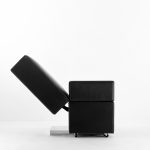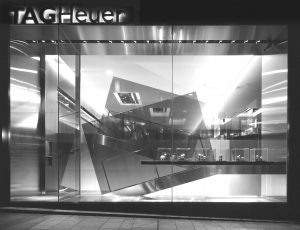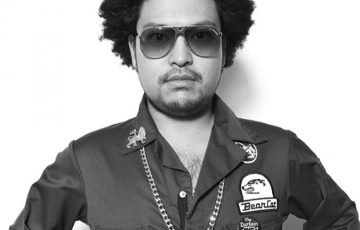In the space of just seven years Gwenaël Nicolas and Rieko Miyamoto have taken the international design world by storm, compiling stunning avant-garde portfolios for corporate clients such as Issey Miyake, Tag Heuer and Sony. Femke Bijlsma caught up with the pair as they put the finishing touches on their biggest project yet – designing their own home.
When Frenchman Gwenaël Nicolas first met Rieko Miyamoto by chance at a party, he sensed the beginnings of something beautiful. Both designers in their own right, the pair had much in common and plenty to talk about. But it took Gwenaël a few days to track down Rieko again after saying goodbye on that fateful night, for she had not been so quick to offer him her business card.
Gwenaël and Rieko are now married, have a daughter, are building their dream house in Tokyo and run their own design company, called Curiosity.
In the seven years since setting up the company, they have gained international fame and recognition. With work ranging from furniture design to shop interiors, from package design to houses, their creativity has no boundaries. They have designed retail space for Issey Miyake, Levi’s and Tag Heuer, perfume packages for van Cleef & Arpels, Gaultier and, again, Issey. Park Hyatt’s delicacies are packaged in a Curiosity creation, and there is a chance you may right now be sitting in one of its chairs.
On a sunny spring afternoon I am shown around their apartment in Yoyogi. A bedroom, a wardrobe and a living room with adjacent kitchen are all there is to see, but rather than imposing, the starkness is pleasant and light. A hand-made wooden bench with a few cushions is the only furniture in the place. Rieko opens the doors to the balcony, which looks out over impressive urban scenery – a dense residential neighborhood that includes an old bathhouse chimney against the backdrop of the Shinjuku skyscrapers. They can enjoy the view another year before they will move to their new house in Shibuya.
While they have been renting an office space in Shinjuku for a few years now, the company started in this apartment. “The office was in the bedroom and we would talk to clients in the wardrobe,” Rieko laughs. It is stiflingly hot and she leaves the room for a moment to change into cooler clothes. “We are never here during the day so I forget how hot this apartment can get,” Gwenaël remarks.
The dedication to their new house appears inconsistent with the fact that they are never home. Gwenaël is eager to explain his motivation, which may well be the foundation of everything he does. “Family is my basis,” he says. “I want to be close to my family as much as possible.” When he started dating Rieko, he found it so unsatisfying that every morning they left the house at the same time, each going to their own jobs in a different direction, that he proposed they work together. Working away from home as he does now, Gwenaël doesn’t get to see his daughter as much as he would like. “The new house will also contain our new office so I can live where I work and my daughter can see what I do.”

SPIDER (TAG HEUER)

MURMURE PERFUME (VAN CLEEF & ARPELS)
The design for the new house is very avant-garde: a glass box enclosing three wafer-thin floor slabs with external ramps attached to the sides. Aside from a summerhouse they are designing for a Japanese client near Mount Fuji, their new home is their first architectural project. By taking on a project of this scale they are affirming their position as ’all-round designers’ and, at the same time, implicitly ridiculing the artificial boundaries created between different design disciplines. Gwenaël, irritated by the fact that architecture often stops with the exterior, has a reason to cross the boundary. “I just don’t like the architecture I see. So often I find the same boring kitchen and dark wasted corridor space on the inside that I want to do it all myself, from the structure to the taps.”
He takes nothing for granted and questions everything before he comes up with a design solution. “For the first time in many years we had to ask ourselves how we wanted to live, what we wanted to see, to feel, everything,” he says. “This house project really involves big questions about ourselves, about architecture, about interior design and product design.” It is indeed rare for an architect to design door handles and lighting, given the tremendous expense involved. But Gwenaël objects to this standard acceptance. “(It) is all a matter of priority. A client gives you a tight budget and the next year you find that they’ve bought a \3-million sofa. They spent all their money on things. I mean, excuse me, if you would have given me that budget, we could have done an incredible house…”
WORLDWIDE IMPACT
In spite of his passion for designing his own house, residential architecture has never been Curiosity’s priority. The impact is too limited and Gwenaël prefers to look at the bigger picture. “Anyone can make a nice design,” he says, adding that it is not only design that counts. Rather he places importance in the entire process, which is a whole different ballgame altogether.
Gwenaël is a man of the world. Born in France and educated in Paris and New York, he first came to Tokyo at the age of 25. Design on an international scale is what interests him and in order to make an impact on the world stage he wants to make designs that everyone can understand. “That’s why we don’t want to do underground projects where 10 people are excited but 20 million people don’t understand,” he says.
Rather than a specific product, it is the process that interests the Curiosity pair. And since “a good project needs a good client,” finding the right client is an essential part of the process – something Rieko seems to have a nose for. “Usually from the first meeting we know if the project will be successful or not,” she says. “In the first 10 seconds of the presentation I sometimes realize it is not going to work.”
One of their main conditions of accepting a commission is that they learn from the project. “The point of design is to learn something,” says Gwenaël. “When you work with a single client on a house, you learn about this person’s life. But when you work for a big company, they teach you all their collective experiences. It’s very enriching.” They want to challenge and be challenged. Question, push, ascend, transcend. “For instance with the Tag Heuer project, I worked with an extremely annoying and critical man who kept questioning everything,” he says. “Every day we talked for hours on the phone, Rieko was almost getting jealous! Now we’re very good friends.”
For Gwenaël, his job comes down to communicating. “My only task is to have a good idea and make sure to explain the idea clearly,” he says. “I need to find one person in the company who understands the concept and who has the power to make it real. Then it will be successful.” The challenge not only comes from outside. “Rieko is my worst critic,” Gwenaël laughs. “I always get mad at first, but I always end up changing it the way she said.”
As they become more and more experienced and recognized, they are also given more responsibility. The commissions are not only limited to “design” but also involve consulting on commercial and creative strategies. “If people want our opinion, we give them a consultation with a straightforward solution,” says Gwenaël. “This weighs heavily on their shoulders, but at the same time gives them the chance to make a significant impact.”
THE SECRET OF JAPANESE QUALITY
Originality, sophisticated detailing and elegance characterize Curiosity’s designs. After only seven years of operation, the company’s work is impressive in both its quantity and quality. According to Gwenaël, the secret lies in the company’s geographic position, which has a production structure that is completely different from that in, say, Europe. “Making a product in Europe goes like this,” he says. “A high-ranking marketing-person goes down to the engineering department, they in turn bring the idea to the company under them and when they finally decide to make the product, two years have passed. In Japan it works the opposite. Millions of small extremely experienced companies are constantly doing research to develop new products with today’s technologies. They present their projects to bigger companies, the “editors” of technology like Toyota. This means they have instant access to updated technology and Toyota can simply choose from them. The Americans and French wonder how they are able to introduce a new finished project on the market in only a few months. The answer lies in the environment. In fact Italy has a system similar to Japan and they (Italian designers) can also make incredibly good furniture in just a few months. It’s the same thing. In the middle of the mountains you find a company like Alessi, surrounded by hundreds of small workshops all incessantly researching different things. That’s how they can come up with great products.”
Gwenaël becomes excited as he explains how he envisions Curiosity as a great hub of technology. He sees enormous potential in people developing products without marketing output but with extensive knowledge and skills. “We want to make use of those ideas,” he says. “In an environment where new products are churned out overnight, it is vital to have fresh ideas ready to put forward at all times. When we are asked to do a showroom for Sony, it has to be done in two months, even though it’s a huge project. If we are not ready at this time with ideas, it’s too late. This is so crazy! So we need to prepare for this by constantly researching new areas.”
Their office, in kind, is a little factory where eight people are designing non-stop upstairs, while downstairs the results are poured out and displayed. All sorts of perfume bottles are laid out on a transparent table and the space is filled with colorful sofas and chairs of Curiosity’s design. The entire staff is Japanese. “All very strong individuals,” Gwenaël assures. “Some people say that the Japanese lack the strong personality of the French or elsewhere in Europe, but that is such nonsense. I am dealing with very strong characters and I have to treat every person differently in order to get the best out of them. They are all incredibly talented. If one person leaves, it is a nightmare for us. That’s how you know it’s a good team.” When asked if his prized employees ever go home, Gwenaël replies, ”Fortunately we also design sofas, so they can sleep there.” It’s difficult to tell whether or not he’s joking.
GOOD DESIGN
One of Curiosity’s most remarkable projects has been the creation of a perfume and its bottle. It was produced in a limited edition of 100, so chances of finding one on the market are few. Luckily Gwenaël and Rieko have one in their home. Consisting of two transparent acrylic tubes, one functioning as a stand while the other contains the perfume, the small glass flask looks more like a miniature abstract sculpture than a bottle. The perfume-tube is balanced horizontally from one end by a hole in the stand, which remains upright due to the delicate balance between the cantilevered bottle and holder.
When asked what good design is, Gwenaël’s brow furls. After a long silence, he finally answers. “I don’t really know. It is a very subjective thing. One thing I know for sure is that it must be beautiful.” He picks up the Curiosity bottle to illustrate. “Good design is like a good perfume that consists of three notes. It needs a top note that is dynamic and cool, but it can’t be only that and too often design stops there. You also need a second note to evoke recognition by stimulating discovery and surprise. The third note is that special something in the design that gives people the opportunity to get attached to it.”
Perhaps the answer lies in the name of the company. By questioning, researching, wondering and experimenting, Rieko and Gwenaël have proven that good design begins with at least one thing – curiosity.



SPIDER SOFA (TAG HEUER)

LVMH (TAG HEUER TOKYO)

BCASSINA IXC (BOOMERANG SERIES)

ME (ISSEY MIYAKE)
Text by: Femke Bijlsma
From J SELECT Magazine, July 2004















Recent Comments